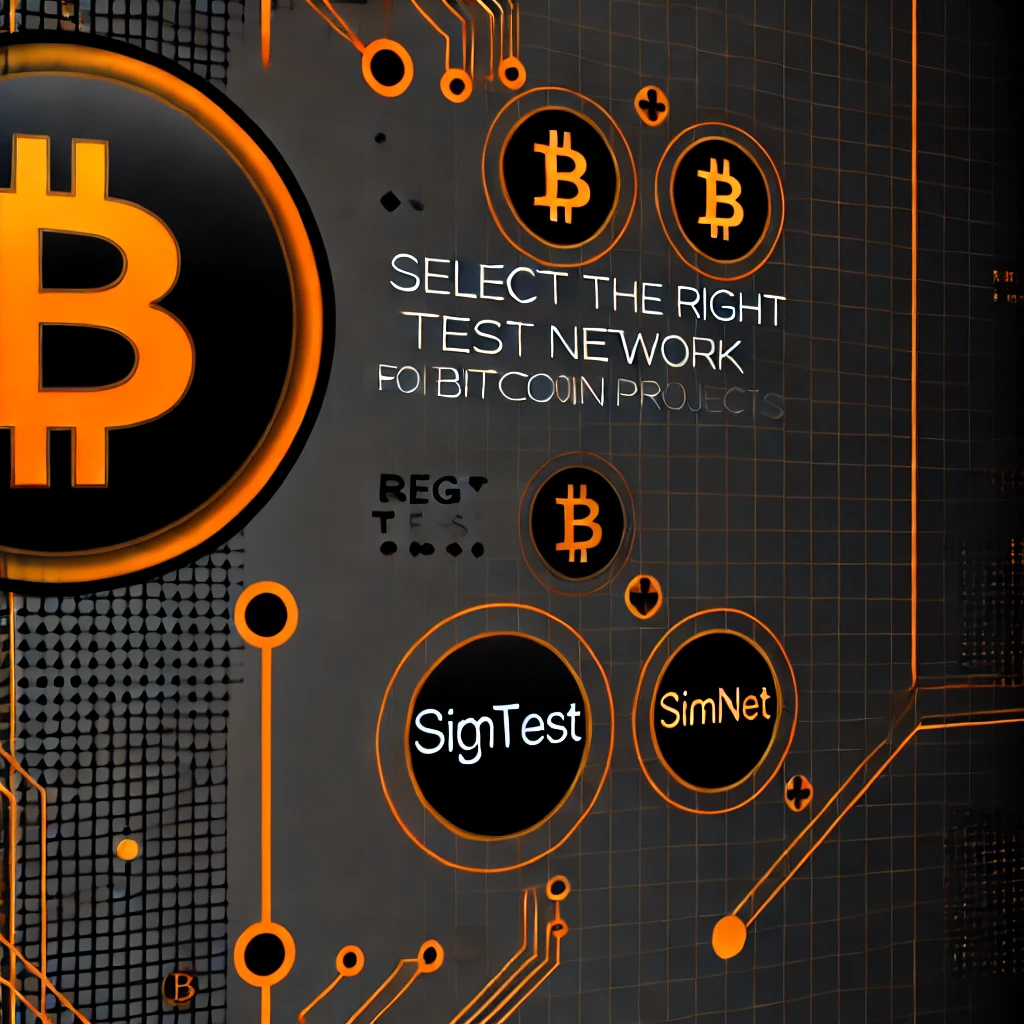
Why Choosing the Right Bitcoin Test Network is Essential for your project.
Developing quality Bitcoin applications requires a robust testing environment where developers can experiment, debug, and validate without risking real assets. This post offers a Bitcoin test networks comparison, covering Regtest, Simnet, Signet, Mutinynet, Testnet3, and Testnet4, which provide ideal playgrounds for testing everything from wallets and payment processors to smart contracts.
Important Note: All the coins on the test networks described have zero monetary value. Do not get scammed. Never pay for test coins on any network!
Recent instability on Testnet3, driven by increased development activity and targeted attacks, has underscored the importance of selecting the right network for your needs. Fluctuating fees and disruptions make it crucial to explore alternatives if you are looking for a stable testing environment.
On the other hand, network fees and traffic spikes are a fact of life on the Bitcoin Mainnet as well as Testnet3, so this may be exactly what is needed for a realistic simulation for your project.
This post will help you navigate the available options, understand their unique characteristics, and choose the best one for your project with a complete Bitcoin Test Networks comparison. By leveraging these networks, you can confidently refine your applications to meet the highest standards of performance, security, and reliability before going live on the Bitcoin Mainnet.
Overview of Bitcoin Test Networks
Bitcoin test networks provide developers with environments to safely experiment, debug, and validate their applications without risking real assets. For the purpose of a Bitcoin test network comparison, these networks can be broadly categorized into two types:
- Local Networks: Designed to run on a developer’s local machine or a private network. These networks allow for complete control over the testing environment, making them ideal for rapid testing, debugging, and edge case simulations.
- Regtest: An entirely local network run only on your machine or a network you set up.
- Simnet: Similar to Regtest but designed to more closely simulate a network environment.
- Public Networks: These networks closely simulate the actual Bitcoin mainnet, providing a realistic environment for testing while still being separate from the mainnet. They allow developers to test applications in conditions that mirror real-world usage without incurring real costs.
- Signet: A public yet centralized network with a predictable, steady environment.
- MutinyNet: A public but managed network, in fact a specific Signet, tailored for specific testing scenarios.
- Testnet3: A public decentralized network that has been the primary testnet for over a decade but has some critical vulnerabilities that have harmed its overall usefulness.
- Testnet4: The latest decentralized public testnet, still gaining adoption. Newly supported in Bitcoin Core V28.
By understanding these different networks, developers can choose the most appropriate environment for their testing needs, ensuring thorough and reliable application development.
Now let’s look at these different options in a little more depth.

Detailed Comparison of Each Bitcoin Test Network
Regtest
Regtest stands for Regression Test Network, and it is a great way to test Bitcoin applications on a local environment.
Standing up a bitcoin node in Regtest requires zero time for blockchain syncing, and thus nodes can be ready to test in minutes, versus hours or days on other test networks.
Another benefit of Regtest is the ability to mine your own test coins. This creates a virtually unlimited supply, enabling developers to simulate extreme edge cases or scenarios that require large volumes of coins.
Check out this video where we mine 10,000 bitcoin to simulate the famous bitcoin pizza purchase:
On the other hand, running on Regtest can make it difficult to simulate applications that require networks of nodes – for example testing oracles, DLCs, Lightning Network applications.
While this lack of a broader network environment limits Regtest’s utility for testing decentralized or multi-party applications, there is a great tool available for developing Lightning projects designed to solve this. The tool is called Polar, and it’s goal is to be the “one-click Bitcoin Lightning networks for local app development & testing.”
Polar really can help developing Lightning Apps in Regtest. If this sounds like a good fit, we recommend checking it out.
Find out more about running Regtest in the Bitcoin Developer Guide.
Simnet
Simnet is very similar to regtest, in that it is designed for local testing and not as a public network. The main difference between Simnet and Regtest is that Simnet is designed to work with BTCD nodes, not Bitcoin Core.
If you are looking to test an LND and BTCD specific application locally, it could be a good fit.
Here’s a great doc that explains the differences between Simnet and Testnet when testing LND: https://github.com/lightningnetwork/lnd/blob/master/docs/INSTALL.md#simnet-vs-testnet-development
Testnet3
Testnet3 has been operational for over ten years and has been the go-to public testing network for bitcoin. It is well supported by all Lightning implementations, many leading bitcoin wallets, and various other protocols, such as Ordinals.
Bitcoin Testnet is similar to the Mainnet in that blocks are mined. So actual bitcoin miners are needed to create new blocks.
However, there are some quirky aspects to Testnet3 that have caused the network to become almost unusable at the time of this writing (October 2024). Tweaks in the network originally designed to ensure that blocks would be mined in case of a lack of mining power have instead caused the production of blocks to skyrocket.
This has reduced the number of testing coins available on the network, and spamming of the network has exacerbated this problem to drive network fees sky high. The shortage of testnet bitcoin also caused the coins to be traded for real value, which was the original reason for deprecating Testnet2.
Except in specific use-cases, we wouldn’t recommend starting new long-term node infrastructure or test applications on Testnet3.
If you decide to build on Testnet3, we recommend using this faucet, as although not always functional, has given us the most consistent results:
https://coinfaucet.eu/en/btc-testnet
If you are testing Lightning applications on Testnet3, this is a great online wallet:
Mempool.space also has a testnet instance that can be used to explore the Testnet3 blockchain – note the waring that the network is considered obsolete:
https://mempool.space/testnet
Testnet4
The next iteration of the Bitcoin Testnet is supported in Bitcoin Core as of version 28, released in October 2024.
Testnet4 is a public, mined testnet similar to Testnet3. However, there have been some subtle tweaks to the code base that prevent large amounts of blocks being mined, the problem that led to the deprecating of Testnet3.
Coins for testing are also available on a faucet available at mempool.space.
Another advantage of Testnet4 is that the blockchain is still small compared to any of the other public networks, making it more economical to run on local computers and virtual private servers.
Also, since the code has been tweaked to prevent the creation of “block storms” the network should be much more stable for long-term testing infrastructure.
Find out more about running Bitcoin Core on Testnet4 here:
Mempool block explorer:
https://mempool.space/es/testnet4
Testnet4 coin faucet:
https://mempool.space/es/testnet4/faucet
Signet
The Bitcoin Signet Network was invented to correct the aspects of the Bitcoin Testnet Network that cause instability. It is designed to more closely mimic the behavior of the bitcoin Mainnet, in that blocks are produced at a steady, approximately 10-minute rate.
Signet is also a public network, however new blocks are signed by a trusted party, rather than mined. This makes public signets centralized and able to steadily produce new blocks at a constant rate.
Many applications support Signet, including Bitcoin Core, Core Lightning and Lightning Network Daemon (LND).
If you decide to go with Signet, here is a faucet for getting coins:
Here’s a block explorer that may come in handy too:
MutinyNet
MutinyNet is in fact a type of custom public signet. It was designed by the makers of the now deprecated Mutiny Wallet, but is still in use and has some really great features in its favor. This is our current go-to for setting up Lightning Network test nodes and applications.
One great feature of MutinyNet is that blocks are confirmed every 30 seconds. This makes testing quite fast as coins and lightning channels are available almost instantly.
Another aspect in MutinyNet’s favor is that it is fully supported by Voltage. This makes setting up a new bitcoin and Lightning node for testing very simple, and at the time of this writing, also free!
However there is one downside here that should be taken into account: Voltage nodes do not allow the creation of Bitcoin Core wallets. So if your testing requires this feature, it will not be a good solution.
There is a whole suite of tools available for MutinyNet, including coin faucet, block explorer and invoice generator here:
Faucet
Block Explorer
Get invoices to pay:
https://lnurl-staging.mutinywallet.com/lnurlp/refunds/callback?amount=1000
If you want to get started with MutinyNet, this tutorial by Voltage could be a great help: https://www.youtube.com/live/0XyPVJDVrVo?si=YmLZVIDJkZt2Dalv
Bitcoin test networks comparison: choosing the right network for your needs
Check out this handy table with a complete Bitcoin test networks comparison.
| Test Network | Type | Main Purpose | Coin Supply | Block Creation | Faucets | Strengths | Weaknesses |
| Regtest | Local | Local testing with full control | Unlimited, mined by user | Instantly by user | No external faucet needed | Fast testing, fully customizable, no sync time | Cannot simulate a broader network, limited for decentralized applications |
| Simnet | Local | Local testing, mainly for BTCD & LND | Unlimited, mined by user | Instantly by user | No external faucet needed | Ideal for LND/BTCD testing, similar to Regtest | Not compatible with Bitcoin Core |
| Signet | Public | Stable network mimicking mainnet | Controlled by trusted party | Approx. every 10 minutes | Signet Faucet | Predictable, steady block generation, good for public app testing | Not much support among apps and wallets we use for testing |
| Mutiny Net | Public | Fast Lightning testing, custom Signet | Controlled by trusted party | Every 30 seconds | Mutiny Faucet | Fast confirmation times, supported by Voltage, great for LN testing | Voltage nodes don’t support Bitcoin Core wallets |
| Testnet3 | Public | Decentralized mainnet-like testing | Limited, mined by real miners | Every 10 minutes, but unstable | Testnet3 Faucet | Supported by all kinds of wallets, lightning implementations and apps | Vulnerable to attacks, high fees, coin shortages, mostly unusable |
| Testnet4 | Public | New decentralized public testnet | Limited, mined by real miners | Every 10 minutes, stable | Testnet4 Faucet | Stable block production, small blockchain, efficient for new tests. Recommended for future proofing if feasible. | Still gaining adoption, not supported by many apps and wallets. Mempool faucet requires authentication. |
In conclusion, each Bitcoin test network serves a unique purpose, offering different environments for developers to test their applications. Regtest and Simnet are ideal for local, fast testing with full control, while public networks like Signet and MutinyNet provide stable, predictable environments for real-world simulations.
Testnet3, though historically significant, faces instability and high fees, making Testnet4 the better choice for long-term decentralized testing. By understanding these networks’ strengths and weaknesses, developers can choose the best one to ensure their Bitcoin applications are thoroughly tested before going live on the Mainnet.
This work is licensed under a Creative Commons Attribution-ShareAlike 4.0 International License (CC BY-SA 4.0). You are free to share and adapt this material for any purpose, including commercially, as long as you provide appropriate attribution and distribute any modified material under the same license.
Attribution Suggested:
“‘Bitcoin Test Networks Comparison: Regtest, Simnet, Signet, Testnet3, Testnet4, and MutinyNet’ by Erik Alvarez (Velas Commerce), licensed under CC BY-SA 4.0.”


